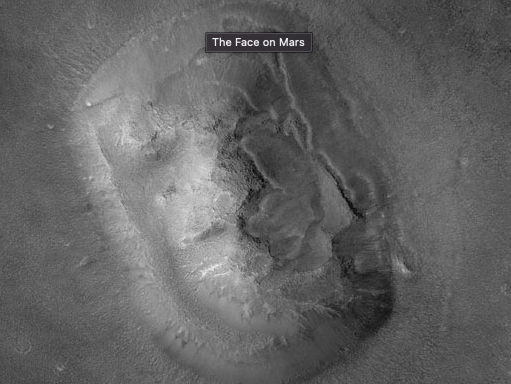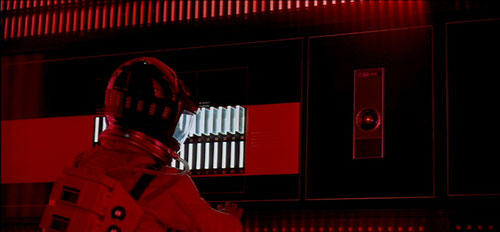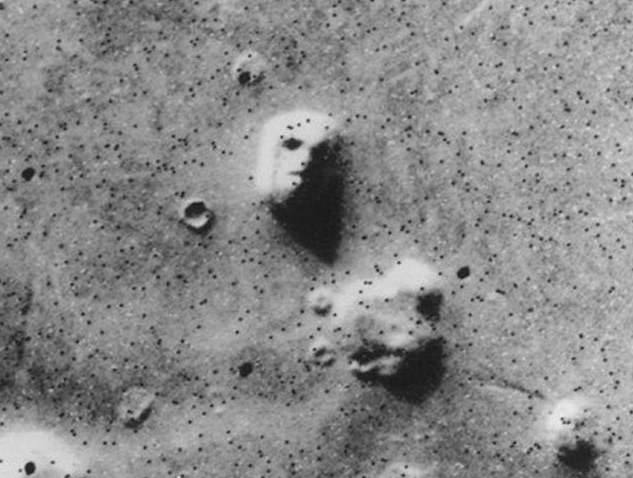The human penchant for seeing patterns is legendary. Recall the “human face on Mars.” For decades it was splashed across the covers of check-out line tabloids. When the Mars Global Surveyor spacecraft arrived at Mars in the late 1990s with a much higher resolution camera than that carried by the Viking I mission in 1976 it was obvious that there was no face at all. Just human brains and reflexive pattern recognition. We can’t stop ourselves.

A much higher resolution image from the Mars Global Surveyor shows that the “face” is just another Martian hill.
This poetry in patterns is the delight of art lovers and conspiracy theorists alike. Not to mention the analysts of cinema on YouTube. During a recent drift through YouTube, I watched a video commenting on Stanley Kubrick’s 2001. The video claimed that any object in the film that was remotely oblong was there to invoke the film’s famous black monolith. And that Stanley had obsessively planned this down to every last angle to underscore the importance of the monolith. The more prosaic explanation is that a rectangle is kinda the natural shape for lots of things and Stanley had a film to finish.
 There was one interesting set of rectangles in the film, however, that I had never seen that way before. It’s when David Bowman (Keir Dullea) releases the memory elements of the HAL 9000 ship’s computer. And as he does so a family of monoliths rise one at a time to take their places in a tableau vivant. The sequence is visually striking, like all of 2001, and it’s emotionally wrenching too. Poor HAL’s memory is going and he can feel it. And we can’t help feel a little sad as well. HAL is a smug prick of a computer, but he does run a tight ship and he exhibits more piss and vinegar in the film than Bowman or his fellow astronaut Frank Poole (Gary Lockwood).
There was one interesting set of rectangles in the film, however, that I had never seen that way before. It’s when David Bowman (Keir Dullea) releases the memory elements of the HAL 9000 ship’s computer. And as he does so a family of monoliths rise one at a time to take their places in a tableau vivant. The sequence is visually striking, like all of 2001, and it’s emotionally wrenching too. Poor HAL’s memory is going and he can feel it. And we can’t help feel a little sad as well. HAL is a smug prick of a computer, but he does run a tight ship and he exhibits more piss and vinegar in the film than Bowman or his fellow astronaut Frank Poole (Gary Lockwood).
With his pride, paranoia and murderous disdain for his fellow crewmembers, HAL is actually the most human character on board the good spaceship Discovery One. Tightly wrapped Bowman and Poole are more akin to lifeless silicon simulations than the marvelously nutso HAL. They’re the robots. They were made to be so by the relentlessly scientific industrialization of modern society — as a popular meme from the late 60s would have it. That we would all become sons and daughters of the computer. Back then, of course, no one foresaw that instead of turning humans all into cold, calculating automatons the future would instead gift us TicToc, Twitter and YouTube, reducing humanity to emotional scrollers intent on sensation with rarely a thought to science.
Anyway, when Bowman does zotz HAL’s memory and force the poor 9000 to devolve into a mindless machine that maintains the ship’s systems, Bowman regains a measure of his humanity. HAL, that epitome of restrictive scientism, is no longer Bowman’s jailer. He’s a free man, able to act on his impulses. So he can’t resist following his curiosity. He climbs into a pod — opening the pod bay doors himself, thank you very much — and flies off to the Stargate and his rendezvous with destiny in the green room where he will go from human to Star child.

